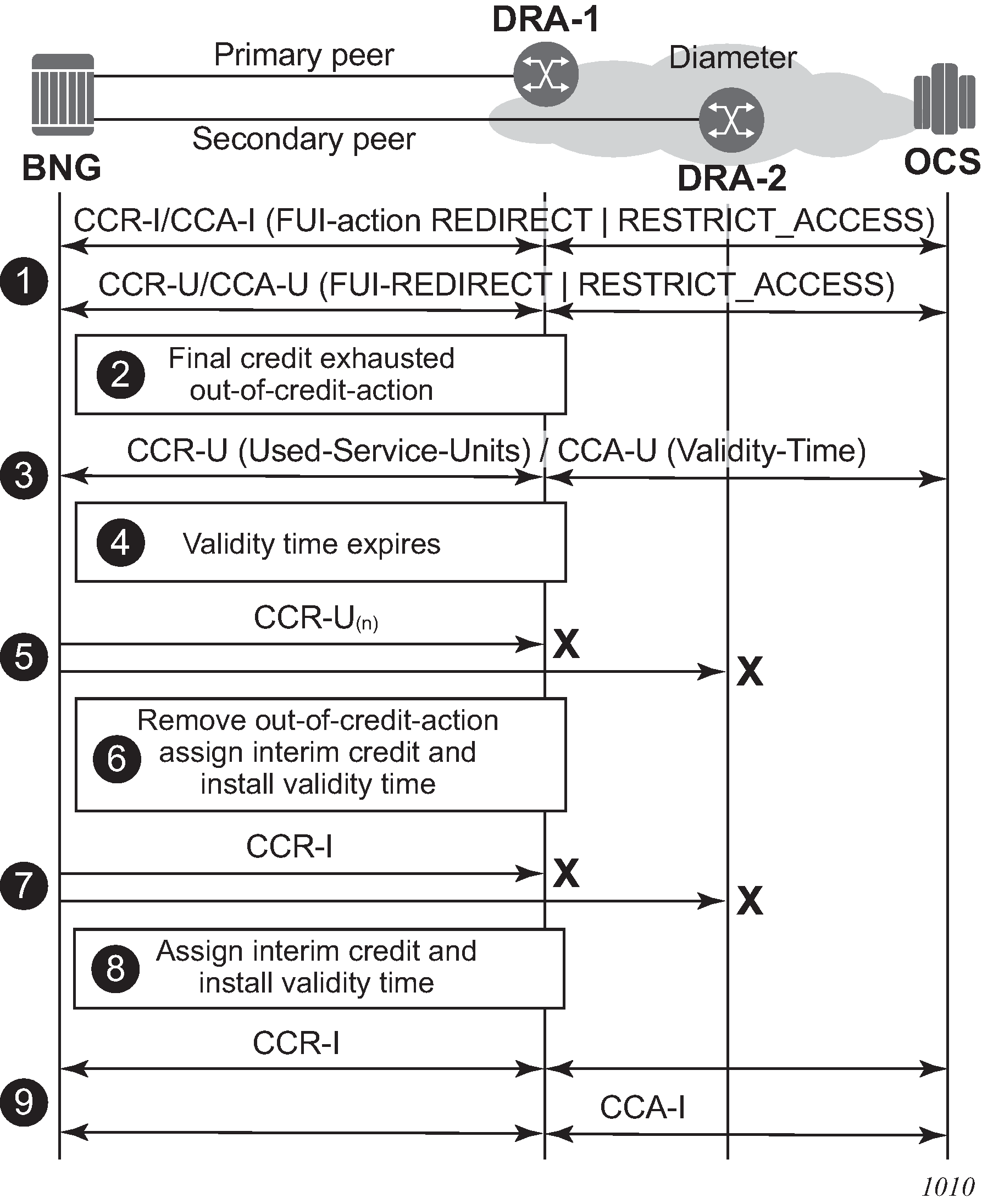This section describes two scenarios where EFH is activated during a graceful service termination initiated by the OCS with a Final Unit Indication (FUI) AVP. A graceful service termination with FUI action equal to REDIRECT or RESTRICT_ACCESS relies on a validity time or RAR to trigger a new credit negotiation with the OCS. Because the OCS is unreachable, it cannot be verified if a new quota has been granted. With EFH enabled, interim credit is assigned to guarantee service to the user until the connectivity with OCS is restored.
In the first scenario shown in Figure: EFH call flow - FUI scenario 1, the OCS initiates the graceful service termination with the Final-Unit-Action AVP = REDIRECT or RESTRICT_ACCESS. EFH is activated immediately after the out-of-credit action is installed.

A Diameter Gy session is in progress. Either the CCA-I or a CCA-U contains the Final-Unit-Indication AVP and the Final-Unit-Action AVP is set to REDIRECT or RESTRICT_ACCESS.
The final assigned credit is exhausted and because the Final-Unit-Action AVP is different from TERMINATE, the provisioned out-of-credit action is installed. A CCR-U is sent to the OCS to notify it that the Final-Unit-Action has started.
The CCR-U message sent to the primary peer times out or an error condition occurs that triggers diameter Gy EFH. If failover is enabled, the CCR-U message is resent on the secondary peer. The CCR-U message sent to the secondary peer times out or an error condition occurs that triggers Diameter Gy EFH.
EFH becomes active for this user session. Interim credit is assigned to all rating groups and, optionally, a validity time is installed. The out-of-credit action is removed.
Interim credit is exhausted for a rating group or a validity time expires. A new attempt is made to establish the Diameter Gy session with the OCS and a CCR-I message (new session ID) is sent to the primary peer. A timeout or an error condition occurs that triggers Diameter Gy EFH to become active. If failover is enabled, the CCR-I message is resent on the secondary peer. The CCR-I message sent to the secondary peer times out or an error condition occurs that triggers EFH.
A new interim credit is assigned to all rating groups and, optionally, a validity time is installed.
Interim credit is exhausted for a rating group or a validity time expires. A new attempt is made to establish the Diameter Gy session with the OCS. A CCR-I is sent with the same or a new session ID to the primary peer. Whether the same or a new session ID is used is determined by a configuration command.
A CCA-I answer message is received. EFH becomes inactive and the user session continues with the new established credit control session. Optionally, the used interim credit can be reported via the new established session.
In the second scenario shown in Figure: EFH call flow - FUI scenario 2, the OCS initiates the graceful service termination with the Final-Unit-Action AVP = REDIRECT or RESTRICT_ACCESS. EFH is activated after the FUI validity time expires.

A diameter Gy session is in progress. Either the CCA-I or a CCA-U, contains the FUI AVP and Final-Unit-Action AVP = REDIRECT or RESTRICT_ACCESS.
The final assigned credit is exhausted and because the Final-Unit-Action is different from TERMINATE, the configured out-of-credit action is installed.
A CCR-U is sent to the OCS to notify that the Final-Unit-Action has started. The server responds with CCA-U containing a validity time.
The validity time expires.
The subsequent CCR-U message sent to the primary peer times out or an error condition occurs that triggers Diameter Gy EFH. If failover is enabled, the CCR-U message is resent on the secondary peer. The CCR-U message sent to the secondary peer times out or an error condition occurs that triggers Diameter Gy EFH.
EFH becomes active for this user session. Interim credit is assigned to all rating groups and, optionally, a validity time is installed. The out-of-credit action is removed.
Interim credit is exhausted for a rating group or a validity time expires. A new attempt is made to establish the Diameter Gy session with the OCS; a CCR-I message is sent to the primary peer. For the first attempt, a new session ID is used. For subsequent attempts, a configuration command determines if a new or the same session ID is used. A timeout or an error condition occurs that triggers Diameter Gy EFH to become active. If failover is enabled, the CCR-I message is resent on the secondary peer. The CCR-I message sent to the secondary peer times out or an error condition occurs that triggers EFH.
A new interim credit is assigned to all rating groups and, optionally, a validity time is installed.
Interim credit is exhausted for a rating group or a validity time expires. A new attempt is made to establish the Diameter Gy session with the OCS, a CCR-I message is sent to the primary peer.
A CCA-I answer message is received. EFH becomes inactive and the user session continues with the new established credit control session. Optionally, the used interim credit can be reported via the new established session.